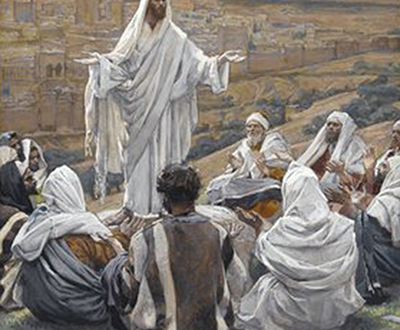
Victory Overtaking Defeat
John 20:1–18 is part of the lectionary readings for Easter Sunday, April 12th. The eyewitness testimony recorded in this passage reminds believers that Jesus truly rose from the dead in space-time history. There is no better message of hope that Christians can proclaim, especially as people around the globe struggle under the crushing weight of the ongoing Covid-19 pandemic.
The Savior’s crucifixion is the prelude to His resurrection from the dead. After the crowd outside the Praetorium (the official Jerusalem residence of Judea’s Roman governor, Pilate) insisted on Barabbas’s release, Pilate ordered his soldiers to flog Jesus.
The military personnel pressed a crown of thorns on Jesus’ head and wrapped a purple robe around Him. Then they repeatedly mocked Him and smacked Him in the face (19:1–3).
Perhaps Pilate thought this harsh treatment would elicit the crowd’s sympathy for Jesus. However, no such compassion was demonstrated. Pilate, after telling the people once more that he found Jesus innocent of any charge, and after parading Him before them in ridiculous attire, presented Jesus to the throng (vv. 4–5).
Pilate soon became disgusted with the heartless attitude of the religious leaders. He told them to crucify Jesus themselves. Yet, they argued that their law required that Jesus be executed, because He professed to be God’s Son (vv. 6–7).
The governor withdrew and asked Jesus to reveal His origin. Jesus’ silence infuriated Pilate, who reminded this peasant that, as governor, Pilate possessed the authority to free Jesus or sentence Him to die on the cross (vv. 8–10).
Pilate’s comment, however, failed to impress Jesus. He told the governor that any authority he had over his prisoner was granted by God.
While Pilate had the power to sentence Jesus to death, Caiaphas had delivered Him to the Roman governor. Therefore, Caiaphas was “guilty” (v. 11) of committing a far more serious transgression. (It is less likely that Jesus, in making this statement, was referring to Judas Iscariot.)
When Pilate searched for some way of letting Jesus go, the religious leaders vociferously warned the governor that Caesar would regard such an act as treason (v. 12). In essence, the religious leaders took what they regarded as a religious offense (blasphemy, since Jesus declared Himself to be the Son of God) and made it into a political offense (sedition, since Jesus claimed to be a king).
Faced with this implied threat, Pilate ordered Jesus to stand before His accusers while the governor sat on the judgment seat (v. 13). It was Friday morning of the Passover week when Pilate pointed to Jesus and contemptuously said to the crowd that He was their “king” (v. 14).
Now, the spectators turned into a mob thirsty for blood. One by one, they yelled for Jesus to be crucified.
Pilate asked the onlookers whether they really wanted him to do this. Ironically, the religious leaders, who had condemned Jesus for slandering the Creator, proclaimed Caesar to be their only legitimate monarch. So, having exhausted all attempts to free Jesus, Pilate, in a spineless display of cowardice, finally caved into the antagonists’ demands and commanded his soldiers to take Jesus away to be crucified (vv. 15–16).
The details of Jesus’ crucifixion are recorded in 19:17–27, His death is discussed in verses 28–37, and His burial is the focal point of verses 38–42. Joseph of Arimathea, a wealthy and prominent member of the Sanhedrin (Matt 27:57; Mark 15:43), was instrumental in arranging for the Messiah’s burial.
Joseph had kept his faith in Jesus a secret, because Joseph was afraid of experiencing scorn from his religious peer. Yet, he had not consented to the council’s decision to condemn Jesus (Luke 23:50–51). Now that Jesus had been executed, Joseph openly expressed his devotion to the Savior by boldly seeking Pilate’s permission to bury Jesus in Joseph’s own tomb (John 19:38; see Matt 27:60).
After Pilate gave his consent, Joseph and Nicodemus took the body of Jesus away. Nicodemus was another member of the Jewish ruling council and the Pharisee who sometime earlier came to Jesus at night to inquire about the kingdom of God (John 3:1–15).
Joseph and Nicodemus retrieved Jesus from the cross and prepared His body for burial. Nicodemus had brought about 75 pounds of myrrh and aloes, and with Joseph dabbed strips of linen with the spices. Next, the two wrapped Jesus’ body with the cloths, in keeping with the proper burial customs of the Jews (19:39–40).
Then, Joseph and Nicodemus took Jesus’ body to a new tomb that was empty of any other corpses. John also mentioned that the tomb was in a garden, which is another indication that the Savior’s body was not placed in a public cemetery.
The tomb was apparently close to the execution site. This was providential, since sundown, which was fast approaching, would mark the beginning of the Passover Sabbath (vv. 41–42).
Mary Magdalene was one of the women who stood near the cross upon which Jesus was executed (v. 25). Early Sunday morning, while it was still dark, Mary was the first disciple to come to the tomb where Jesus’ body had been laid to rest (20:1).
Mark 16:1 states that Mary came to Jesus’ tomb after the Sabbath to pour spices over His body, which was a cultural expression of love for the dead person. Such devotion on Mary’s part was not unusual. After all, Jesus had exorcised seven demons from Mary (Luke 8:2).
As an early follower of Jesus, Mary proved to be an energetic and caring person. She not only traveled with Jesus, but also contributed to the needs of His other disciples.
When Mary came to the tomb, she saw that the “stone had been taken away from the entrance” (John 20:1). She and the other women with her wondered how they would be able to move the massive object away from the entrance.
The women’s concern vanished when they discovered that the rock had already been removed. Though it was still early, they could see that Jesus’ tomb was empty.
Mary ran to find Peter and the “other disciple” (v. 2), who most likely was John (the author of the Fourth Gospel). Mary frantically told them that people had transferred Jesus’ body to an unknown location. Mary probably thought that Jesus’ enemies had stolen His body and had not considered the possibility that the Father had raised the Son from the dead.
Understandably, Peter and John were alarmed by Mary’s statements. This prompted the two disciples to run to Jesus’ tomb to see for themselves whether the body was missing (v. 3). It turns out that John outran his peer and arrived first at the empty sepulcher (v. 4).
For centuries skeptics have considered the Gospel writers’ resurrection accounts as myth or legend. In this regard, it is significant that, after Jesus’ resurrection, He first appeared to Mary Magdalene and then assigned to her the responsibility of informing His other disciples about His return to the Father.
In Jesus’ day, the testimony of women mattered little judicially and socially. So, no ancient Jewish author would have made up such a story about a woman being the first eyewitness to this momentous event.
Further undermining Mary’s testimony was her being from Magdala, a city the religious leaders condemned for its wickedness. Also, as noted above, Mary had a history of demon possession (Luke 8:2). So, even if she seemed cured, skeptics would have questioned the credibility of her assertions. Consequently, John’s objective, unbiased account fortifies the historical veracity of Jesus’ resurrection.
Why didn’t the Savior first appear to Peter or John, two of Jesus’ most prominent disciples? His logic isn’t the same as that of the prevailing culture. Also, the testimony of Jesus’ death and resurrection is still being entrusted centuries later to unlikely candidates who, like Mary, will faithfully follow through in sharing the good news with others.
The major truth to be proclaimed on Easter Sunday is that Jesus of Nazareth, our Savior, has risen from the dead. Knowing this makes all the difference in the world. It spells the difference between despair and joy, and between turmoil and peace.
In ancient times, the entrance to private burial chambers was often less than three feet high. So, an adult would have to bend down to look inside.
John did this and saw the strips of linen that had been used to cover Jesus’ body. Yet, at first, John decided not to go into the tomb (John 20:5).
When Peter arrived, he immediately entered the sepulcher (v. 6). The apostle saw both the strips of linen and the face cloth that had been placed around Jesus’ head. The cloth was rolled up in a spot by itself (v. 7).
These details indicate that thieves had not stolen Jesus’ body, for it is unlikely that anyone who had come to remove the corpse would have bothered to unwrap it before removing it. Shortly thereafter, when John went inside the tomb, he saw the evidence and “believed” (v. 8).
Admittedly, the exact nature and full extent of John’s belief are not explicitly stated in the biblical text. For instance, did John believe that Jesus had risen from the dead, or did John now believe Mary, who had told Peter and John that the tomb was empty?
The answer continues to be debated. What is clear is that, at this time, neither Peter nor John had a full understanding of Scripture’s teaching about Jesus’ resurrection (v. 9). Once Peter and John finished observing the tomb, they returned to their lodgings in Jerusalem (v. 10).
Evidently, Mary had returned to the tomb with Peter and John. At this point, Mary had not yet figured out that Jesus was risen from the dead.
Mary still thought bandits had stolen Jesus’ body, and this possibility so traumatized Mary that she “stood outside facing the tomb, weeping” (v. 11). At some point, Mary decided to look inside the sepulture, and when she did, she saw two white-robed angels sitting at the head and foot of the place where the body of Jesus had been lying (v. 12).
Even while Mary was reexamining the tomb, she continued to cry. This prompted the angels to ask her, “Woman, why are you weeping?” (v. 13).
Mary explained that she was grieved over the possibility that Jesus’ body had somehow been stolen. The fact that Mary was unable to attend to Jesus’ body and give Him a proper burial could have added to Mary’s distress. She still did not realize that her Lord had risen from the dead.
At that moment, Mary sensed the presence of another individual. She turned and saw a person standing outside the tomb with her, but she did not realize it was Jesus (v. 14).
Perhaps there was something different about the risen Lord that prevented not only Mary, but also His other friends, from recognizing Him (Luke 24:13–31; John 21:4). Or it might be that they were supernaturally prevented from recognizing Jesus until the time was right (as determined by the Savior).
Mary thought that Jesus was the local “gardener” (John 20:15). In response, Jesus first addressed Mary as “Woman,” just as the angels had done. Next, like the angels, Jesus asked Mary why she was “weeping,” and inquired whom she was seeking.
Previously, Mary imagined that Jesus’ enemies had stolen His body, but now Mary hoped that this person, whom she assumed was responsible for the upkeep of the private cemetery, might have moved the body.
Mary did not answer Jesus’ questions, but implored Him to reveal the whereabouts of the Savior’s corpse, if He had carried it away. Mary promised to return the body to the tomb herself. Yet, how she planned to do this on her own remains unclear.
In an earlier episode during Jesus’ earthly ministry, He referred to Himself as the good Shepherd. He noted that when He called His sheep by their name, they would know His voice (10:3).
Something like the above must have occurred for Mary, because she recognized the Lord when she heard Him say her name. Mary’s immediate reaction was to turn again toward Jesus, but this time to exclaim, “Rabboni!” (20:16).
Mary had spoken in Aramaic, which was the language the people of Palestine used in Jesus’ day. John explained to his readers that “Rabboni” meant “Teacher.”
According to Matthew 28:9, when Mary Magdalene and another disciple named Mary encountered the risen Lord, they fell to the ground, clasped His feet, and worshiped Him. John’s account provides further insight into this incident by revealing Jesus’ instruction to Mary Magdalene (John 20:17).
It wasn’t that Jesus forbade Mary to touch Him at all. Rather, the phrase, “Do not continue to cling to me,” conveys the idea of, “don’t tenaciously clutch onto me.”
It seems that Mary wanted to never let go of the Lord she thought she had lost. Yet, He had an ascension for Himself and an assignment for her. Specifically, Mary was to return to the rest of the disciples with the wonderful news of Jesus’ victory over death.
Although Jesus had not yet ascended, He wanted to assure His followers that in due course He would be returning to His heavenly Father. The Son spoke about His Father and His God as their Father and God.
Now that Jesus’ redemptive work was fully accomplished, the reconciliation between God and His spiritual children was complete. Appropriately, Mary obeyed Jesus by rushing to the disciples.
Mary told her peers that she had actually seen the risen Lord. Mary also related the message Jesus had entrusted to her. Undoubtedly, Mary’s abrupt ascent from the depths of grief to the heights of joy astonished the rest of the disciples (v. 18).
Key ideas to contemplate
God shone His light into the darkness of death on Easter morning. Concededly, the empty tomb might be difficult for us to understand. Even so, it is no reason for us to doubt that Jesus truly has risen from the dead. The promise connected with the empty tomb is that the Savior enables us to triumph over sin and death, and live to bring glory to God.
1. THE ULTIMATE SUFFERING. In Jesus’ suffering, He, the victim, identified with us. Although He was the Son of God, He laid aside His privileges and, as the Son of Man, experienced our human condition. He felt the loneliness of rejection, the humiliation of ridicule, and the excruciating physical pain of crucifixion.
The Son, in taking our sins upon Himself on the cross, experienced the ultimate suffering—total separation from the Father. That separation is something those who believe in the Lord Jesus will never have to experience.
2. A NEW BEGINNING. After giving up His own life, Jesus was buried. From all outward appearances, the movement He had begun died with Him. The disciples were in hiding, fearful for their lives. It seemed as if Jesus’ antagonists had won and Satan had been victorious.
Yet, the last chapter had not been written. Jesus’ resurrection from the dead vindicated His claim to be the Messiah. Also, His rising from the dead inaugurated a new beginning for His followers, along with all creation.
3. VICTORY OVERTAKING DEFEAT. Jesus’ resurrection is a promise of our own resurrection and victory over sin, suffering, and death. Though our ultimate victory will be realized when we one day join the Messiah in heaven, we can, like the first disciples, also be victors here on earth.
The moment Mary Magdalene heard Jesus call her name and she responded to Him, she shared in His victory. By focusing on the Son, Mary’s despair turned to joy, and so can ours.
4. HOPE REPLACING FEAR. Because Jesus conquered death, He is able to offer us new life. And because He rose from the dead, He is able to give us the hope of His abiding and caring presence. With our risen Lord by our side, we can face an uncertain future with confidence rather than fear.




